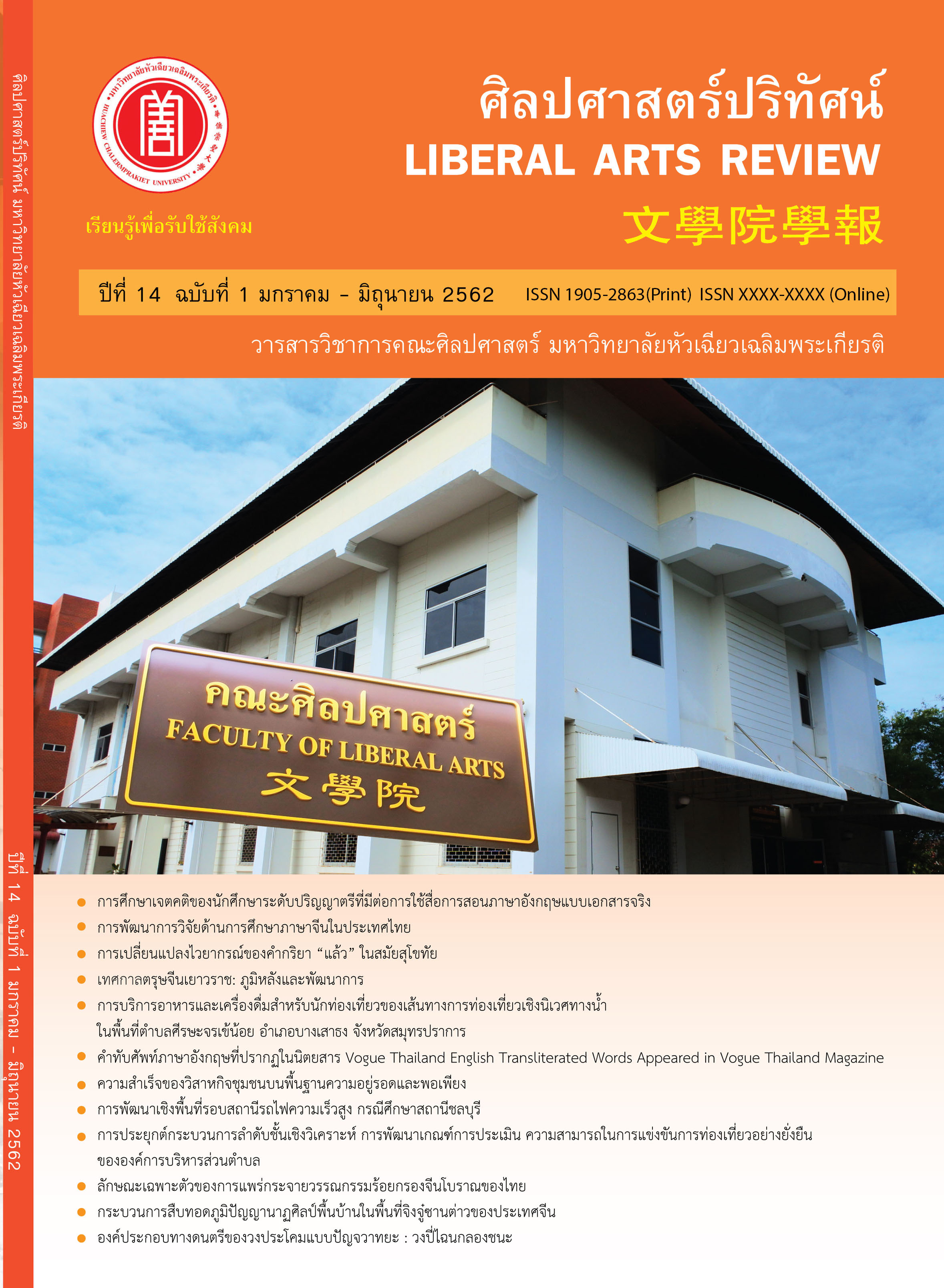Community Enterprise Success on the Basis Viability and Sufficiency
Keywords:
Community Enterprise, Participation, Viability, Sufficiency, Self-sufficiencyAbstract
This article has the objectives to studythe background, principles,goals, andthe work of community enterprisesthat ledtothe group’s successon the basis of survival and sufficiency. Also,itaimsto study the adaptation process and the operational directionof thecommunity enterprises in today's economic and social fluctuationas well as the trend of the survival adaptation.This study uses documentaryresearchtounderstandthebasics,conceptdetailedinformation, and field study. The research areas areGroup Rak Don-Chedicommunityenterprise inSuphanburi,BanChanodecommunity enterprise, andBan-klongyongLan-TakfahinNakhonPathom. This will lead to theunderstanding and analysis of their principles and processes.
The results indicated that the community enterprise’s success has3 major factors: (1) Leadership and virtue of the enterprise’s leader, (2) Members of group must have time to regularly participateinthe community enterpriseactivities, and (3) Participation and grouplearning of every member in the enterprise. Nevertheless, the real success needs a cleargoal settingof the enterprise which is viability and self-reliance. It makes members realize their wish, their duty, and their goal throughout the group process within the enterprise. They will ask for help from another organization only when necessary; which is mainly related to technology and marketing. Thisleads them to change their thinking process; which isto understand and prioritizework with the idea of self-sufficiency. Furthermore, the vision of the enterprise is to create another generation of members bothinshort-term and long-term which areto teach them the goal and the processwithin the group, to give community and people knowledge, and to share this knowledge to another community. These determine that the enterprise will survive evenifthere are no former members.
References
จินตนา กาญจนวิสุทธิ์. (2558).เส้นทางวิสาหกิจชุมชนเพื่อการพัฒนาอาชีพและการพึ่งตนเอง.กรุงเทพมหานคร: มีน เซอร์วิส ซัพพลาย.
ดวงเดือน สมวัฒนศักดิ์. (2548). วิสาหกิจชุมชน.ชัยนาท:สำนักงานส่งเสริมและพัฒนาการเกษตรเขตที่1 จังหวัดชัยนาท กรมส่งเสริมการเกษตร.
ทักษญา สง่าโยธิน.(2560).ปัจจัยแห่งความสำเร็จของการดำเนินงานวิสาหกิจชุมชน.วารสารวิทยาลัยพาณิชยศาสตร์บูรพาปริทัศน์,12(2),11-25.
มนเทียร โรหิตเสถียร. (2549). การดำเนินงานของวิสาหกิจชุมชนกลุ่มผลิตภัณฑ์จากผ้าในจังหวัดเชียงใหม่.(การศึกษาอิสระมหาบัณฑิต). มหาวิทยาลัยเชียงใหม่, เชียงใหม่
รังสรรค์ ปิติปัญญา. (2542).ศักยภาพของชุมชนในการทำธุรกิจชุมชนอุตสาหกรรม. Applied Economics Journal, 5(2), 99-113.
วราภรณ์ ศรีบุญ. (2552).ปัจจัยที่มีผลต่อความสำเร็จในการดำเนินงานของผู้ประกอบการผลิตภัณฑ์ชุมชนและท้องถิ่น (OTOP) ในจังหวัดสงขลา. (วิทยานิพนธ์มหาบัณฑิต).มหาวิทยาลัยสงขลานครินทร์, สงขลา.
สมชัย จิตสุชน.(2559).พระบาทสมเด็จพระเจ้าอยู่หัวรัชกาลที่9 กับเศรษฐศาสตร์: ศาสตร์พระราชากับการแก้ปัญหาความยากจนและความเหลื่อมล้ำอย่างยั่งยืน.ค้นคืนจากhttps://www.pier.or.th/?post_type=abridged&p=3580
สิทธิณัฐ ประพุทธนิติสาร. (2546).การวิจัยเชิงปฏิบัติการแบบมีส่วนร่วม:แนวคิดและแนวปฏิบัติ.กรุงเทพมหานคร: สำนักงานกองทุนสนับสนุนการวิจัย.
สิริวรรณ ฉลูศรี. (2554).การสังเคราะห์งานวิจัยที่เกี่ยวกับการพัฒนาวิสาหกิจชุมชนในประเทศไทย. (วิทยานิพนธ์ปริญญามหาบัณฑิต). มหาวิทยาลัยสุโขทัยธรรมาธิราช, นนทบุรี.
สุภางค์ จันทวานิช. (2552).วิธีการวิจัยเชิงคุณภาพ(พิมพ์ครั้งที่ 17).กรุงเทพมหานคร: สำนักพิมพ์แห่งจุฬาลงกรณ์มหาวิทยาลัย.
เสรี พงศ์พิศ. (2548).ฐานคิด จากแผนแม่บทสู่วิสาหกิจชุมชน.กรุงเทพมหานคร: เจริญวิทย์การพิมพ์.
เสรี พงศ์พิศ. (2549). เศรษฐกิจพอเพียงการพัฒนายั่งยืน.กรุงเทพมหานคร: เจริญวิทย์การพิมพ์.
เสรี พงศ์พิศ. (2552).คู่มือการทำวิสาหกิจชุมชน.กรุงเทพมหานคร: เจริญวิทย์การพิมพ์.
Downloads
Published
How to Cite
Issue
Section
License
บทความที่ได้รับการตีพิมพ์เป็นลิขสิทธิ์ของวารสารศิลปศาสตร์วิชาการและวิจัย
ข้อความที่ปรากฏในบทความแต่ละเรื่องในวารสารวิชาการเล่มนี้เป็นความคิดเห็นส่วนตัวของผู้เขียนแต่ละท่านไม่เกี่ยวข้องกับมหาวิทยาลัยหัวเฉียวเฉลิมพระเกียรติ และคณาจารย์ท่านอื่นๆ ในมหาวิทยาลัยฯ แต่อย่างใด ความรับผิดชอบองค์ประกอบทั้งหมดของบทความแต่ละเรื่องเป็นของผู้เขียนแต่ละท่าน หากมีความผิดพลาดใดๆ ผู้เขียนแต่ละท่านจะรับผิดชอบบทความของตนเองแต่ผู้เดียว




